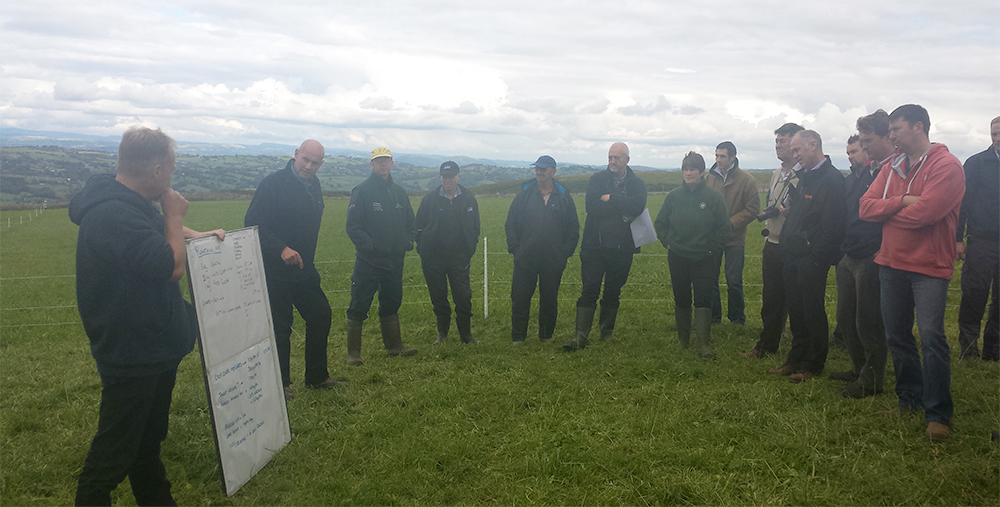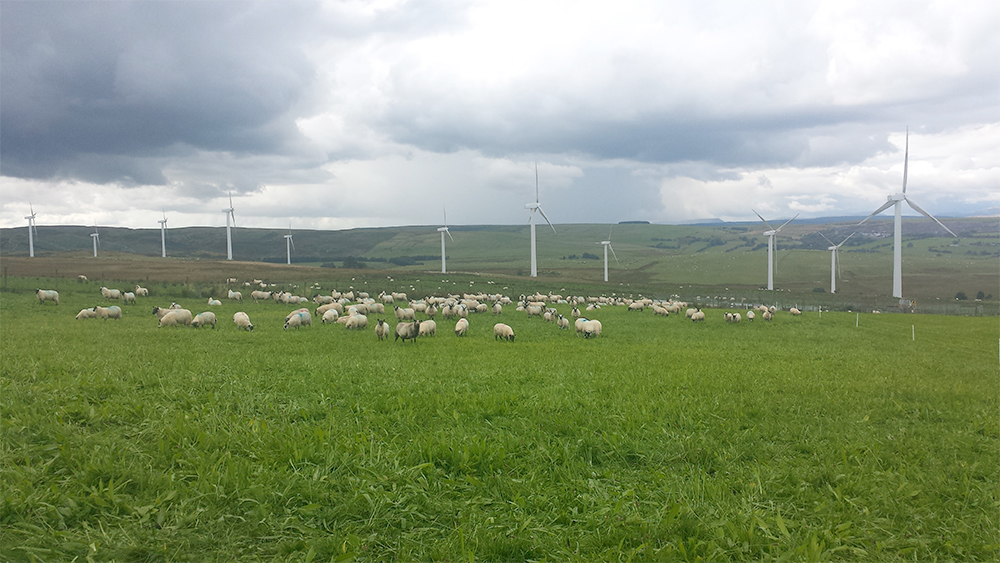
In a bid to maximise return from the land and increase productivity per hectare, FUW farming stalwart John Yeomans and his wife Sarah have adopted a rotational grazing system to maximise the use of crops and grazing.
They opened the gates to the family farm, Llwyn y Brain, to share their experience with fellow farmers on what has worked for them over the past two years.
The event was well attended by industry representatives and farmers alike and provided an excellent opportunity to see how the Yeomans family have incorporated new crops such as plantain into their rotational grazing systems and what measures they take to maximise livestock health.
“Getting through tough times is about maximising sheep feed and putting more liveweight on the stock we have. After the snow in 2013 we lost a considerable amount of money and add to this that we will be losing almost two-thirds of our single farm payment, we knew we had to do something,” said Mr Yeomans.

John and Sarah run a herd of 73 cows consisting of pedigree Limousin, Limousin x, Belgian Blue x, and 15 home bred replacement heifers (closed herd) which are calving at approx. 2 years.
They further keep 495 ewes which are mainly Beulah and 160 Beulah ewe lambs and the flock has been closed since 1981.
The couple sell Beulah draft ewes and some yearlings, as well as Welsh Mule ewe lambs for breeding and sell finished lambs on a deadweight basis.
The sheep are individually recorded and lambs are tagged at birth on farm since 1986. The couple are also founder members of the Beulah Sire Reference scheme, which was set up in 1996.
The 232 acres of owned farm land sit between 750 feet to 1420 above sea level, with 100 acres (34.8ha) of lower land and 132 acres (53.4ha) of largely improved hill land. A further 53 acres of additional land is rented.
“We either have to look at ways of how we can carry on farming and be more profitable or give up; and we don’t want to do that. So we started to implement rotational grazing as a way of being more efficient and make use of every bit of grass and crop to optimise output.
“To find our feet with the new system of grazing, we decided to implement a three year trial to get a fair idea of what is going to work for us and what isn’t. Ewes and lambs are moved to hill ground in late May. About ten days later they are moved into one mob on each hill block and rotationally grazed around it.
“Once weaned we split the lambs into 3 groups. 1 group we are feeding which are mainly mule ewe lambs and we added some of the younger lambs to this group.
“A control group of around 100 and this year it was a third of mule ram lambs and a third of Beulah ram lambs and then continental cross lambs.
“The remaining lambs are rotationally grazed using a Kiwikit solar powered electric fence and they are moved every 3 days on to fresh pasture.
“As is often the case with farming, not everything went to plan. What this trial has proved to us is that whilst individual animals may not grow quite as fast on a rotational grazing system, the total weight gain per hectare is vastly increased when compared to set stocking.
“For the first time this year we have added plantain as a crop, which looks promising. Due to its nutritional qualities it is well suited to lactating ewes with lambs or finishing weaned lambs.
“Following a visit to another farm as part of our Cefn Coch ATB discussion group last year, we were inspired by the results the farmer, Tom Jones and his family, had with plantain so we decided to give it a go with the aim to put 200g plus liveweight gain per day on the lambs or 1.5kg per week.”
John and Sarah split a 12 acre block of hill ground into 4 parcels and sowed 3 kg of tonic plantain, 2 kg of AberHerald and AberCrusader white clover and 1 kg of AberClaret red clover from Germinal Seeds, which is grazed for 6 days, before lambs are moved to the next parcel.
It provides 1 kg of dry matter per day for lamb intake on the 1 hectare paddock size and produces a total of 1120 kg of dry matter in total available forage.
Plantain is rich in minerals due to its deep tap root, which can access nutrients less available to more shallow-rooted crops such as grasses and clovers and is also said to reduce Faecal Egg Count (FEC) in lambs and may reduce the use of anthelmintic treatments.
Livestock health is paramount to the Yeomans family, which is why their ewes are all given a 10 in 1 vaccine in February, are wormed with Cydectin at turnout, given Agrimin trace element boluses pre-tupping, get treated with a Flukicide at weaning, tupping and housing and the lambs are given Cydectin at 8-10 weeks old and a 2g copper pill plus trace element boluses and Clik pour-on.
They are further given 2 x Heptavac P treatments.
Retained ewe lambs are given a copper pill and trace element bolus in late September and are given Heptavac P, Toxovax, Enzovax and flukicide.
The rams are home-bred but the family buy in Beulah rams, Blue Faced Leicester and Charollais. The new rams are then treated with several wormers, flukicide and Heptavac P on arrival and are isolated.
Visitors to the event further learned how John and Sarah maintain the herd health by vaccinating their cows against leptospirosis, BVD and rotavirus.
They are members of the Biobest Health Scheme and calves undergo blood testing for Johnes and BVD. And are proud to be accredited with BVD free status and have had no cases of Johnes disease on farm.
“We strive to be as economical and efficient as possible to maximise our output and increase profit. We go through trial and error to find out what works for us and can only encourage others to try new tactics in order to become more profitable.
“We hope that everyone enjoyed the visit and was able to take information away with them that is helpful to their own holdings. I would like to also thank our grassland consultant Chris Duller, Trefaldwyn vets, Dunbia, Elanco, Zoetis, Opico, DowAgroSciences, Germinal (British Seed Houses), Agrimin, Sainsbury’s, Patchwork and Kiwikit for their continued support and guidance,” added Mr Yeomans.
